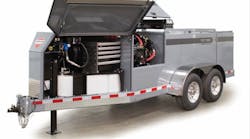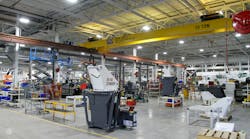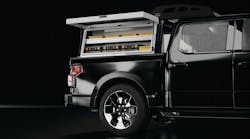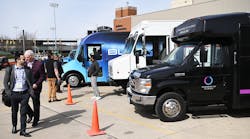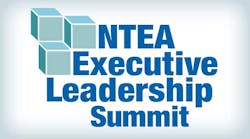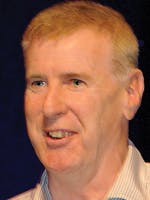EVEN if you’re in the commercial vehicle market in Arkansas or Idaho, what happens in China or Europe or South America matters to you and can have a profound impact on your business.
That was the message delivered by Tim Campbell, managing director of TruckWorld TV, in his presentation, “Understanding the Global Commercial Vehicle Market and Its Impact on Your Company.”
The key takeaways:
• The global market means the US market. “You are an integrated part of everything that’s going on from now on. If you think change has been fast the last five years, it’s going to get even faster.”
• Upfitting will become a more global industry. “I’ve already had inquiries from people in Europe, saying, ‘Are the manufacturers over there looking to cross into Europe?’ ”
• NTEA members should look at global opportunities. “Every time Chrysler or GM or Nissan produces a new van or produces somewhere else in the world, that’s an opportunity, whether you’re making a tail light, a body, or shelving for them. They are all the same van. I’m a great believer in the opportunities.”
• This is a two-way relationship. “They might come across here or you might go across there. It can work both ways.”
Consulting firm Deloitte analyzed what it feels will be the trends in the truck market from 2014 to 2024:
• While Daimler will defend its position as the #1 truck manufacturer, Tata will seize growth in India to overtake Volvo, Dongfeng, and Volkswagen.
• Growth is not global, but regional, with India contributing the largest share—377,000 additional units sold in 2024.
• The BRIC markets will remain the world’s largest truck markets.
• India will supersede the US as the world’s second-largest market.
• Struggling European countries such as Spain and Italy are expected to have a recovery by 2024.
Campbell said that in the 1980s and ’90s, there were three totally separate markets: North American, Europe, and Asia.
“The markets never talked to each other, and all products were completely different,” he said. “There was no synergy. We were all in isolation and went on our merry way. That’s changed a heck of a lot. The main drivers of this economy are legislation and truck chassis manufacturers.
“The Nissan NV 200 is produced in Japan, Europe, and Asia. If you are an upfitter, you can sell van interiors for the NV 200 anywhere, because it is exactly the same van. Fiat Doblo is the Promaster City. Now the Promaster City is going back to Europe. The GM vehicle is the same Fiat Doblo that Ram sells.”
Other significant developments:
• In February, Andreas Reschler took over as head of commercial vehicles for Volkswagen. He was hired from Daimler, where he was the company’s global chief.
“He’s probably the most important person in the world for commercial vehicles,” Campbell said. “He brought Daimler into the US and spearheaded everything that’s going on with Daimler and vans into the US market. Last year, Volkswagen came along and said, ‘Name your price.’ VW was one of the largest commercial truck manufacturers, but not in the US.”
• The first Chinese heavy-duty work truck is now in Europe.
“We’ve been waiting and looking around. But in March, we saw a work truck from Sinotruk. If they can develop it for Europe, they can develop it anywhere. It’s supplied as one complete vehicle. It is not going to be customized. They said, ‘That’s going to satisfy 80% of the markets.’
“A cement mixer and tipper are going into the construction market. They’re known for rugged construction because their roads are very poor. They’re not attacking the tractor market and not taking in the Class 8 market at all. They see their window of opportunity as a work truck.”
• DAF Trucks, a subsidiary of PACCAR, is now building vehicles and bodies on a production line, so they’re selling a complete vehicle.
“They used to have two production lines. They’ve now gotten rid of one of the production lines. The dealer sells directly to the end user. It’s the first time it’s happened. European companies are not doing it. PACCAR is doing it in conjunction with a bodybuilder who supplied the vehicle as kit. The body is kit form produced on the line and then taken across to the end user.”
• EWVTA (European Whole Vehicle Type Approval).
“We used to be able to type-approve the chassis and that was sufficient. The bodybuilder upfits were put on and then it gets registered and the end user gets it. Unfortunately in Europe, some bodybuilders, particularly in new vehicles, were not doing the job properly. Now, if you’re going to put a dropside on a Sprinter, you, as the upfitter and bodybuilder, will have to get your own type-approval certified, go to the manufacturer and get that dropside and get it type-approved for that chassis. Every upfitter will have to get an individual Whole Vehicle Type Approval. This has had a major effect on bodybuilders and manufacturers. The result is that upfitters are consolidating and focusing on a certain segment. Guess what the manufacturers are saying? They’re saying, ‘We don’t have enough resources. Since the recession, our engineering and technical departments have been slashed by 50%, so we don’t want all you bodybuilders coming to us, wanting approval. We don’t have the manpower to do it anymore.’ Chassis manufacturers are cherry-picking and choosing the companies they want to do business with. The good news is once you get type-approval, you can then sell in all 28 European countries.” ♦
